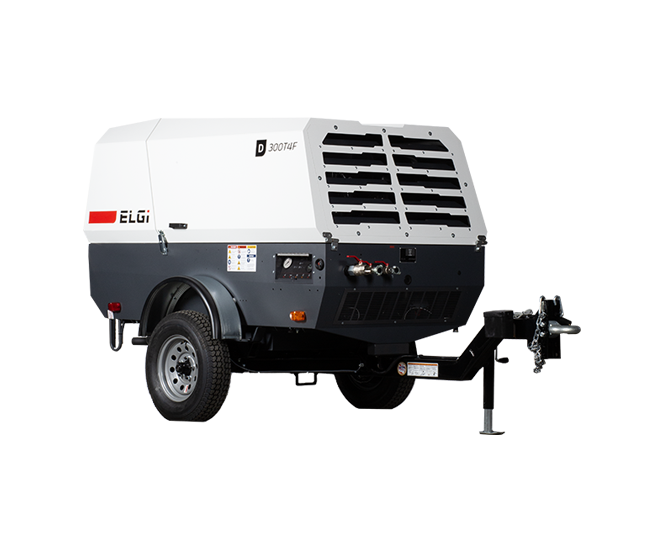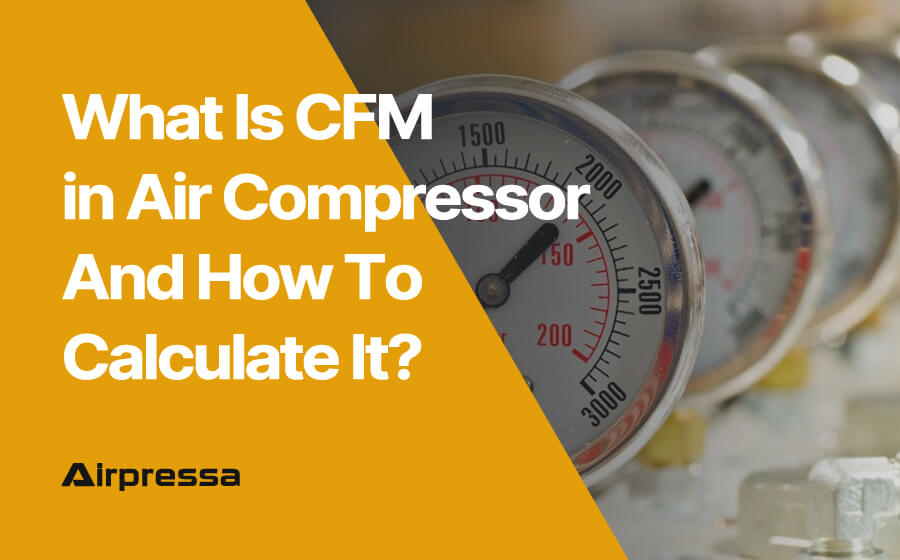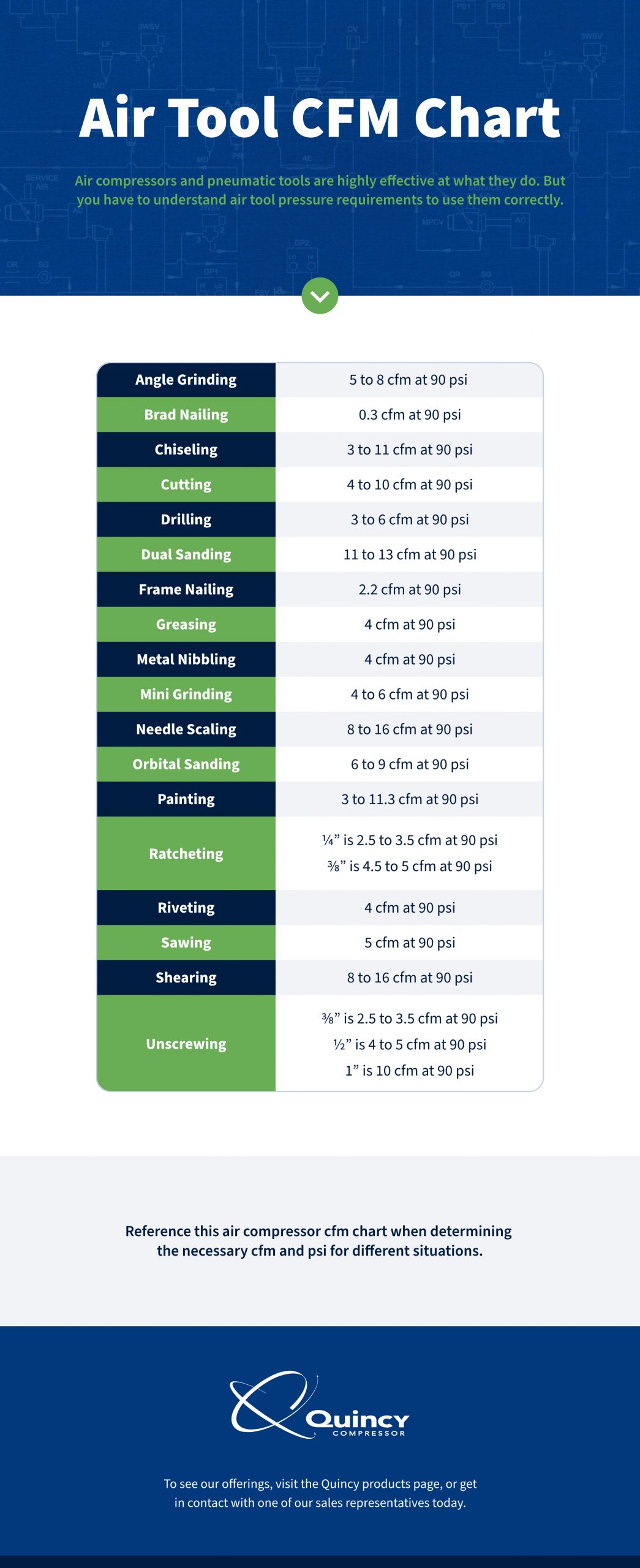CFM in air compressors stands for Cubic Feet per Minute. It measures the volume of air the compressor can deliver.
Understanding CFM is crucial for assessing compressor performance. This metric helps determine if a compressor can handle the air demand of specific tools or tasks. A higher CFM indicates a greater capacity for air delivery, which is essential for operating multiple tools simultaneously or for applications requiring continuous air flow.
Choosing the right CFM ensures efficiency and longevity of your equipment. Always match the CFM rating of the compressor with the requirements of your tools to optimize performance and avoid overloading the system. Proper knowledge of CFM contributes to better decision-making and enhanced productivity in various applications.

Importance Of Cfm
The importance of CFM in air compressors cannot be overstated. Understanding CFM is key to ensuring optimal performance. This section delves into why CFM matters and its role in air compressors.
Definition Of Cfm
CFM stands for Cubic Feet per Minute. It measures the volume of air an air compressor delivers. Simply put, it tells you how much air is flowing. Higher CFM means more air is delivered.
Role In Air Compressors
The CFM rating determines how efficiently an air compressor performs. It indicates the compressor’s capability to power various tools. Different tools require different CFM levels. For example:
| Tool | Required CFM |
|---|---|
| Air Hammer | 4-5 CFM |
| Impact Wrench | 2-3 CFM |
| Paint Sprayer | 6-7 CFM |
Matching the CFM rating to your tool’s requirements ensures smooth operation. Tools that need higher CFM will perform better with a high-CFM compressor.
Using a compressor with insufficient CFM can lead to inefficient performance. It may cause tools to operate poorly or stop working.
To choose the right compressor, consider the CFM needs of your tools. Always check the CFM rating before purchasing an air compressor. This ensures you get the best performance and longevity from your tools and compressor.

Calculating Cfm
Understanding CFM (Cubic Feet per Minute) is crucial for air compressor performance. Calculating the correct CFM ensures your compressor meets your needs. This guide will help you calculate CFM accurately.
Basic Formula
The basic formula to calculate CFM is straightforward. Use the following equation:
CFM = (Volume of Air in Cubic Feet) / (Time in Minutes)For example, if your compressor moves 50 cubic feet of air in 2 minutes, the CFM is:
CFM = 50 / 2 = 25 CFMFactors Affecting Cfm
Several factors can affect CFM calculations. These factors include:
- Pressure: Higher pressure can reduce CFM.
- Temperature: Warmer air expands, affecting volume.
- Altitude: Higher altitudes can decrease air density.
- Humidity: Moist air can impact air volume.
| Factor | Impact on CFM |
|---|---|
| Pressure | Reduces CFM at higher levels |
| Temperature | Expands air, affecting volume |
| Altitude | Decreases air density |
| Humidity | Impacts air volume |
Consider these factors when calculating CFM for accurate results.
Cfm Vs. Psi
Understanding the terms CFM and PSI is crucial for air compressor users. These terms help in choosing the right equipment for your needs. This section will explain their differences and impact on performance.
Differences Explained
CFM stands for Cubic Feet per Minute. It measures the volume of air delivered by the compressor. PSI stands for Pounds per Square Inch. It measures the pressure of the air delivered.
CFM shows the amount of air a compressor can produce. PSI shows the force with which the air is delivered. Both are important for different reasons.
Impact On Performance
The performance of an air compressor is influenced by both CFM and PSI. Higher CFM means the compressor can deliver more air. This is essential for tools that require a steady airflow.
Higher PSI means the air is delivered with more force. This is crucial for tasks that need strong pressure, like inflating tires.
| CFM | PSI |
|---|---|
| Measures air volume | Measures air pressure |
| Important for continuous tools | Important for high-pressure tasks |
| Higher CFM = More air delivered | Higher PSI = Stronger force |
Both CFM and PSI are essential for choosing the right air compressor. Understanding their roles helps in making informed decisions.
- CFM affects the volume of air.
- PSI affects the pressure of air.
Knowing the difference between CFM and PSI helps in selecting tools. It ensures optimal performance for your tasks.
Optimizing Cfm
Optimizing the CFM (Cubic Feet per Minute) of your air compressor is crucial. Proper optimization ensures the compressor performs efficiently. It also extends the life of your equipment. Understanding and managing CFM can save you time and money.
Proper Sizing
Proper sizing of your air compressor is key. An undersized compressor will struggle to meet demand. This can cause equipment to wear out quickly. Conversely, an oversized compressor uses more energy than necessary.
- Calculate your CFM needs accurately.
- Consider the tools you use regularly.
- Check manufacturer specifications for CFM requirements.
Maintenance tips
Regular maintenance helps keep your compressor running smoothly. Proper maintenance also ensures it delivers the required CFM. Here are some essential tips:
- Check and replace air filters frequently.
- Monitor and maintain proper oil levels.
- Inspect hoses and connections for leaks.
| Maintenance Task | Frequency |
|---|---|
| Replace air filters | Monthly |
| Check oil levels | Weekly |
| Inspect hoses | Weekly |
Following these tips ensures your air compressor provides optimal CFM. This helps your equipment run efficiently.
Cfm In Different Applications
The term CFM stands for Cubic Feet per Minute. It is a measure of the flow rate of air. Different applications require different CFM rates. Understanding these needs is crucial for selecting the right air compressor. This section will explore the CFM requirements in various applications.
Industrial Use
In industrial settings, air compressors perform heavy-duty tasks. These tasks include powering pneumatic tools, running conveyor systems, and operating machinery. Industrial applications often demand a high CFM rate.
For instance, a large-scale manufacturing plant may require air compressors with a CFM rating of 100 or more. This ensures seamless operation and efficiency. Below is a table outlining typical CFM requirements for some industrial tools:
| Tool | CFM Requirement |
|---|---|
| Impact Wrench | 4-5 CFM |
| Paint Sprayer | 6-7 CFM |
| Sandblaster | 6-25 CFM |
Home Use
Home applications usually require lower CFM rates. These applications include inflating tires, running small air tools, and painting projects. A typical home air compressor might have a CFM rating between 2 to 5.
An example is using a brad nailer for woodworking. This tool typically needs about 0.3 to 0.5 CFM. Below is a list of common home tools and their CFM needs:
- Airbrush: 0.5-1 CFM
- Staple Gun: 1-2 CFM
- Finish Nailer: 2-3 CFM
Understanding your specific CFM requirements helps you choose the right air compressor. This ensures efficiency and longevity for both industrial and home use.
Common Myths About Cfm
Many people misunderstand the role of CFM (Cubic Feet per Minute) in air compressors. This misunderstanding leads to several common myths. These myths can affect your choice of an air compressor. Understanding the facts will help you make better decisions.
Higher Cfm Means Better
One common myth is that a higher CFM always means a better compressor. This is not true. CFM measures the volume of air the compressor can deliver. More CFM does not always mean better performance. The right CFM depends on your specific needs. Using tools that require high air volume needs high CFM. But for small tasks, a lower CFM may be enough.
Cfm And Power Consumption
Another myth is about the relationship between CFM and power consumption. Many think higher CFM means higher power use. This is not always correct. The power consumption of a compressor depends on its motor and design. Efficient compressors can deliver high CFM without using more power. Always check the efficiency ratings when choosing a compressor.
| CFM | Use | Power Consumption |
|---|---|---|
| Low (under 5 CFM) | Small tools, home use | Low |
| Medium (5-15 CFM) | Workshop tools | Moderate |
| High (15+ CFM) | Industrial use | High |
Understanding these myths helps you make better choices. Choose the right CFM for your needs. Look at the efficiency and not just the CFM rating.
Choosing The Right Compressor
Choosing the right air compressor is crucial for your needs. The correct CFM (Cubic Feet per Minute) rating ensures optimal performance. A compressor with the right CFM rating will meet your demands effectively.
Assessing Needs
First, assess your needs. Determine the tools you will use. Each tool requires a specific CFM. Create a list of your tools. Note the CFM rating for each tool.
- Identify all tools you will use.
- Find out the CFM requirements for each tool.
- Add up the total CFM needed.
Make sure to consider if multiple tools will run together. This impacts the total CFM required. Choose a compressor that meets or exceeds this total.
Comparing Models
Next, compare different compressor models. Look for the CFM rating in the specifications. Compare the CFM with your total requirement.
| Compressor Model | CFM Rating | Power Source |
|---|---|---|
| Model A | 5 CFM | Electric |
| Model B | 7 CFM | Gasoline |
| Model C | 10 CFM | Electric |
Compare power sources as well. Electric compressors are suitable for indoor use. Gasoline compressors are useful for outdoor tasks.
Choose a compressor that matches your needs and preferences. Ensure the model you choose can handle the workload effectively.
Future Trends In Air Compressors
In the evolving world of air compressors, future trends are shaping the industry. These trends aim to enhance performance and sustainability. Understanding these trends helps in choosing the right compressor for your needs.
Technological Advances
Technological advances are transforming air compressors. New sensors are improving efficiency and accuracy. Smart compressors can adjust settings automatically. This ensures optimal performance under different conditions.
Another exciting development is the use of artificial intelligence. AI can predict maintenance needs before problems occur. This reduces downtime and extends the life of compressors.
Energy-efficient motors are also becoming popular. These motors consume less power while providing the same output. This is great for reducing operational costs and conserving energy.
Sustainability And Efficiency
Sustainability is a key focus in the air compressor industry. Manufacturers are using eco-friendly materials and processes. This reduces the environmental impact of production.
Efficiency is another major trend. Modern compressors are designed to use less energy. This is achieved through better design and advanced technology. High-efficiency compressors produce less heat and run cooler. This increases their lifespan and performance.
Many companies are now investing in renewable energy sources. Solar-powered compressors are an example. These units use sunlight to generate power, reducing reliance on fossil fuels.
Below is a table summarizing some of the key future trends:
| Trend | Description |
|---|---|
| Technological Advances | Smart sensors and AI for better performance |
| Energy-Efficient Motors | Motors that use less power |
| Sustainability | Eco-friendly materials and processes |
| Renewable Energy | Solar-powered compressors |

Frequently Asked Questions
What Does Cfm Mean In Air Compressors?
CFM stands for Cubic Feet per Minute. It measures the volume of air an air compressor can deliver. Higher CFM ratings indicate the compressor can supply more air, essential for running multiple tools efficiently.
Why Is Cfm Important For Compressors?
CFM is crucial as it determines the efficiency of air tools. Tools require a specific CFM to operate effectively. Insufficient CFM can lead to poor performance or tool damage.
How To Calculate Cfm For Air Compressors?
Calculating CFM involves measuring the air output at a given pressure. Manufacturers often provide these specifications. Always match the compressor’s CFM with the tool’s requirements for optimal performance.
What Affects An Air Compressor’s Cfm?
Several factors affect CFM, including the compressor’s size, design, and motor power. Environmental conditions like temperature and altitude can also influence the CFM output.
Conclusion
Understanding CFM is essential for optimal air compressor performance. Proper CFM ensures efficiency and longevity. Always check your compressor’s CFM rating before purchase. This helps match it to your specific needs. With the right CFM, your air tools will operate effectively, saving time and energy.
Make informed decisions for better productivity.

